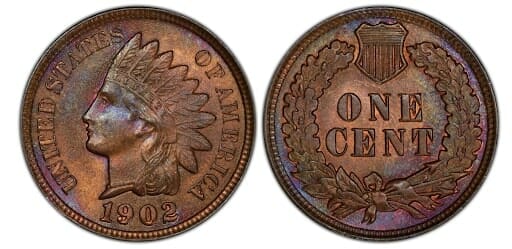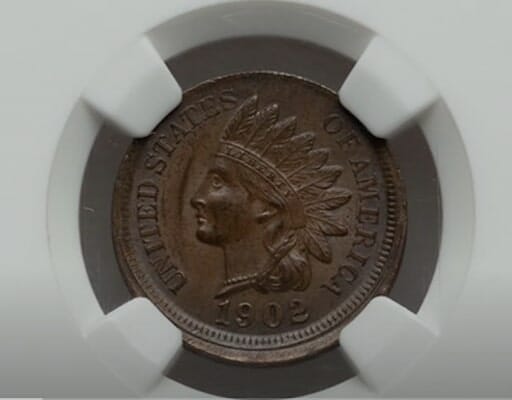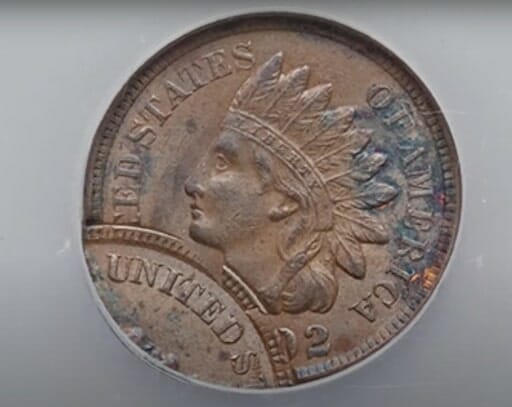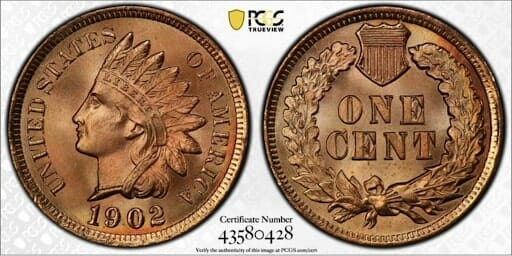The so-called Indian Head Penny was a one-cent coin issued by the United States between 1859 and 1909. The weight and design of Indian Head pennies changed slightly over time because of various economic and political crises. Indian Head Pennies were issued in very large numbers. That makes them common enough to be accessible but with plenty of rarities!
1902 was not a particularly dramatic year for the Indian Head coins. However, because collectors usually want to build complete sets, with coins issued every year between 1859 and 1909, the market for 1902 examples is strong.
The Indian Head Penny series has been popular with collectors since the late 19th century. They were collected while the coins were still being made, in part due to the popularity of the Indian Head imagery.
1902 Indian Head Penny History, Composition, And Characteristics
History of the 1902 Indian Head Penny
87,376,704 copies of the Indian Head Penny were issued by the Philadelphia Mint in 1902. These coins could circulate for decades, making examples in very fine condition rare and valuable.
Composition of the 1902 Indian Head Penny
The 1902 Indian Head Penny was made from 95% copper, with a 5% addition of zinc and tin.
Description of the Obverse and Reverse of the Coin
The obverse of the 1902 Indian Head Penny displays a female bust facing to the left. She has flowing hair and wears a feather headdress with the word ‘LIBERTY’ on the headband. Beneath the bust is the date: 1902. To the left of the bust, the inscription reads UNITED STATES, continuing OF AMERICA around the righthand side of the bust.
The reverse of the 1902 Indian Head Penny features an oak wreath, open at the top and tied at the bottom with a ribbon in a bow. The bow also binds together three arrows, with their points facing right. In the middle of the wreath are the words ONE CENT. At the top of the design is a striped shield.
Around the edge of both obverse and reverse is a fine-toothed design.
1902 Indian Head Penny History
The Indian Head Penny was designed by James B. Longacre, who had been Chief Engraver at the US Mint since 1844. The Indian Head Penny is considered to be his most famous creation and has given birth to romantic stories about its origins.
In 1858 the Director of the Mint wrote to the Treasury Secretary, assuring him that the image of Liberty was not a portrait of any member of Longacre’s own family. This seems to have been a response to a rumor, perhaps made more elaborate over time, that Liberty was based on a sketch of Longacre’s eldest daughter. In its fullest version, the story went that one day, while he was designing the Indian Head Penny, Longacre’s 12-year-old daughter happened to try on a headdress belonging to a visiting group of Native Americans.
However, in 1858, Longacre’s eldest daughter was a grown woman, and Longacre himself said that the portrait was inspired by an ancient Greek statue, which was then on view in Philadelphia. Longacre did regularly draw his eldest daughter, and some people have pointed to a similarity between her image and the Liberty portrait, so it is possible that he subconsciously created a female figure who looked a little like his daughter, but that is all there is to a famous story.
The traditional feathered headdress, or war bonnet, on the coin, is similar to examples worn by honored warriors of the indigenous nations of the American Plains, including the Cheyenne and Lakota. The Indian Head Penny image, however, does not depict any specific headdress style, and this kind of headdress would never have been worn by a woman. The ‘Indian Head’ figure was purely a creation of Longacre’s imagination.
1902 Indian Head Penny Value
1902 Indian Head Pennies are usually worth $1-2. However, a pristine copy can fetch more than $140,000. Look out for fairly common errors, which can often make $200-2000. Value varies significantly with the condition.
Related: Rare & Valuable Pennies – Find Out Which Pennies Are Worth Money
Valuing a 1902 Indian Head Penny
There are two factors to consider when valuing a 1902 Indian Head Penny. There is a big difference between coins in a very fine condition, without scratches, nicks, and dents, and coins that are more worn. Coins with a reddish color also tend to be preferred to coins that are more brown in color.

This example of a brown, mint state/uncirculated 1902 Indian Head Penny, in fairly good condition (63 on a scale of 60-70), with no other distinguishing features, sold for $94 in 2022 and its 2023 estimated value is $110
The other factor is production quality. Minting errors of all sorts can add value to a 1902 Indian Head Penny.
The final value of any 1902 Indian Head Penny is usually a combination of the rarity of any errors and its overall condition: an error-free, a proof copy can fetch the highest value. Damaged coins with an unusual error but in good condition are also very collectible.
Related: 1899 Indian Head Penny Value
Examples of different values based on Specific Grading and Rarity
A very fine, regularly struck 1902 Indian Head Penny can sell for more than $2000, like this one, which reached $2,200.

Introduction and circulation of the Indian Head Penny
Indian Head Pennies were introduced in 1859 to replace one-cent coins with flying eagles on them. The new design rapidly became popular and, except for periods when there were metal shortages or distribution problems caused by the US Civil War, several tens of millions of Indian Head Pennies were issued every year. They continued to circulate long after the design stopped being made in 1909.
Related: 1901 Indian Head Penny Value
Changes made to the design over the years
The design of the Indian Head Penny was approved in 1858 and was first produced for public use in 1859. A wreath of laurel leaves changed to an oak wreath in 1860. In 1864, the alloy of the coin went from 88% copper and 12% nickel to 95% copper with a 5% tin and zinc admixture. This made the coins lighter and slightly less golden in color.
After 1864, the design stayed the same until the type was discontinued in 1909, except that, between 1908 and 1909, some Indian Head Pennies were made in San Francisco. These coins carry an ‘S’ mintmark underneath the Indian Head bust. Before this, all Indian Head Pennies were minted in Philadelphia, with no mint mark.
Related: 1907 Indian Head Penny – A Closer Look at This Elusive Coin
1902 Indian Head Penny Errors and Varieties
Common errors on the 1902 Indian Head Penny
The 1902 Indian Head Penny was produced in large numbers (87, 376, 704). As a result of the coin’s low face value and these large numbers, examples of errors are not uncommon.
These errors can include: faint traces that the 1902 date was punched into the coin die after it had been made; coins struck off-center so that parts of the blank are visible around the main coin design; double-struck coins or blockages, in which two coins have accidentally been stamped together.
1902 Indian Head Penny Off-Center

This 1902 Indian Head Penny has been struck off-center: compare the top and the bottom of the coin to see where the toothed edge has almost disappeared off the edge of the coin (top) and where there is a wide area of blank metal between it and the edge of the coin (bottom). This example sold for around $345.
1902 Indian Head Penny Double Strike

In this example of a 1902 Indian Head Penny, a double-strike is clearly visible, in the form of a second impression (in the lower left) struck on top of the first strike. Here the -02 digits of the date are still visible. Even though its overall condition is not very good, this coin sold for over $650.
Another error to watch out for is a so-called ‘eye gouge’. This looks like a strong diagonal line, sloping downwards from right to left beneath the eye of the ‘Indian Head’ figure.
Spotting errors on 1902 Indian Head Pennies
Many common errors in 1902 Indian Head Pennies are easy to spot with the naked eye. Look out for blank spaces around the design. The Indian Head Penny design should have a toothed border around the rim of the coin on both sides. If this is more than 1mm from the edge on some parts of the coin and not visible in other parts, you have an off-center strike.
Double strikes or blockages usually look like part of one coin stamped over another: look out for semi-circular interruptions to the main design.
To spot other errors, you may need a magnifier. Spotting a 1902 date that has been punched into a die can be tricky: you’ll need to look out for tiny marks around the edges of the 1902 numerals.
Catching pieces with an eye gouge is much easier if you spend a little time looking at pictures of examples with and without the eye gouge: train your eye, then look out for those specimens!

This 1902 Indian Head Penny has a very clear eye gouge and is in very good condition for a coin that has been in circulation. It made $425 in 2021, and its current guide price, according to PCGS, is $225.
Value of errors on 1902 Indian Head Pennies
The value of errors on 1902 Indian Head Pennies is a combination of rarity and visibility and always needs to be considered alongside the overall condition of the coin.
A 1902 Indian Head Penny with an eye gouge is usually around five times the value of an identical 1902 penny without an eye gouge.
In the case of errors like off-centeredness and double-striking, the percentage of the coin that is affected will raise the value. The more of the surface that is missing, damaged, or obscured by the error, the higher the price will usually be.
Mintmarks on 1902 Indian Head Pennies
Until 1908, Indian Head Pennies were only struck at the Philadelphia Mint. For one year, between 1908 and 1909, they were also struck in San Francisco. Examples struck in San Francisco carry a small ‘S’ on the reverse of the coin below the wreath. Coins made in Philadelphia did not use any mintmark, so your 1902 Indian Head Penny should not have a mintmark.
How to Store and Care for Your 1902 Indian Head Penny
Caring for your 1902 Indian Head Penny
Coins are pretty robust: after all, they were made to circulate hand-to-hand for years! However, since the condition is so important to their value, it is important to store and care for your Indian Head Penny properly.
Preservation Techniques for the 1902 Indian Head Penny
In the first place, try to store each coin on its own. Coins rubbing against each other become scratched and worn. You can buy cabinets with trays that have square or round slots for each coin.
If your collection is still small or you cannot use cabinets for some other reason, you can buy plastic capsules that will hold each coin and protect it from wear. These are essential if you have a pristine, mint-condition coin since touching one of these can immediately reduce its value.
How to avoid damaging the coin
Although older coin cabinets, made of wood, are very beautiful, plastic trays and cabinets will keep your pennies safer: wood ‘breathes’ as it ages and creates a slightly acidic environment that damages coins over time.
This same acidity is produced by most paper and cardboard, so if you prefer to keep your coins in paper envelopes (one coin per envelope), or if you want to keep labels with your coins in their cabinet or capsule, make sure that you buy pH neutral, conservation-grade paper. Never stick anything to your coin or write on it. This will diminish its value.
Unless your coin is in pristine, mint condition, it is fine to handle it carefully, but make sure that you wash and dry your hands before picking it up and try to hold the coin only by the edges. Faint traces of acid from human sweat will also mark and corrode a coin over time.
Authenticity and Counterfeit Concerns
How to identify authentic 1902 Indian Head Pennies
The 1902 Indian Head Penny is not a very common target for forgers. 1877 is more often forged because it is the rarest year for this series. There are some common things to look out for, though.
Red flags to look out for when purchasing a 1902 Indian Head Penny
The first thing to check is the weight of your example. A genuine 1902 Indian Head Penny should weigh 3.11 g. Next, try dropping your coin from a very small height (a couple of centimeters) onto a wooden table. Make sure it has a good metallic ring to it. If your example is in pristine condition, you may not want to risk this check, but if your coin already has some wear, this won’t do it any harm.
Make sure that the lettering of the inscription is even and crisp. The feathers on the headdress should look sharp and detailed.
The expression on the face of the woman wearing the headdress should be neutral. Her nose should be straight, and she should look straightforward. On forged coins, the woman may have a furrowed eyebrow or a curved nose, or her chin may be tilted upwards.
The best way to spot any of these differences is to look at plenty of images of genuine coins online or to handle genuine examples at coin fairs if you can. Familiarity is the best forgery detection tool!
Common counterfeit techniques used to fake coins
There are five common ways to fake modern coins, like the 1902 Indian Head Penny.
1) Forgers may make a mold using a real coin, then cast copies. These will often look ‘fuzzy’ in comparison to genuine coins and may have a faint seam around the rim.
2) Spark erosion forgeries use an electrolytic bath to create a new die out of a genuine coin. Forgeries made using this die will have a slightly grainy appearance.
3) Electrotyping involves pressing a genuine coin into soft metal, electroplating the inside of this impression, then filling in the coin and joining the two halves. Electrotypes can look extremely accurate but often be the wrong weight, will not sound right if dropped, and may have a seam around the edge.
4) Transfer die counterfeiting creates a die that is an exact replica of an original coin, with all of its unique wear, errors, scratches, etc. These can be very deceptive, but look out for incorrect weight and a strange sheen or color to the metal. The best way to spot these forgeries is by using a respectable coin dealership website, such as NGC. They keep track of examples that all have exactly the same flaws.
5) If one number in the date on your Indian Head Penny has a lot of scratches around it, and none of the others do, you may have an example of a forger altering a coin with a common date to make a rarer one. This is not as big a problem for the 1902 Indian Head Penny as for other years, especially 1877.
Buys & Selling Your 1902 Indian Head Penny
Strategies for selling your 1902 Indian Head Penny
Do you want to sell a 1902 Indian Head Penny? First, check for any unusual features, like mint errors or an eye gouge, and check its overall condition. You can evaluate its condition using the PCGS coin grading guide.
If you think your coin may have some unusual features or be in very fine condition, it may be worth getting it professionally evaluated. You can do this via an online service, such as PCGS, at a coin fair, or at a local coin dealer’s shop.
Factors to consider when selling your coin
When selling your 1902 Indian Head Penny, make sure that you sell it through an established coin dealership, either using a large online auction service, a national or regional coin fair, or an established coin dealer’s shop. Avoid general auction sites, as you are unlikely to get the best price, and these sites often sell many forgeries.
How to get the best value for your coin
To get the best price for your coin, especially if you are fairly new to coin collecting, get your coin valued professionally. You may not spot details that make it more collectible. Many places offer valuation services, and you don’t have to sell your coin with them. You could also look up local numismatic societies or collector groups, where you might be able to get some free advice.
If you are listing your coin online, make sure that you use standard terms for its condition and any unusual features. This will ensure that interested buyers find your coin. ‘1902 Indian Head Penny/Cent, G-6, eye gouge’ will be more likely to find the right audience online than ‘Cent coin with a figure wearing an Indian headdress, made in 1902, in good condition and with an unusual shape to the eye’, even though they both convey the same information.
Conclusion
The 1902 Indian Head Penny was issued in large numbers in the United States of America as part of a long-running and popular one-cent coin type. Examples can be worth $1-2 or $140,000+ depending on their condition and any unusual mint errors. Because collectors are usually looking for an example of every year in which Indian Head Pennies were issued, there is a strong market for 1902 pieces.

This perfect, entirely uncirculated, and blemish-free 1902 Indian Head Penny sold at auction in 2022 for $144,000, the highest ever recorded price for this coin type.
Coins are fascinating objects because they are incredibly common and can be incredibly rare: they are everywhere. We grow up with them. We all know what coins are, but when you start collecting, finding just the right one or an especially rare example can still be challenging and exhilarating. The 1902 Indian Head Penny sits right in this sweet spot: it was produced in large numbers and can help you to complete a full run of Indian Head Pennies without spending a fortune, but you can also find a real treasure.
Indian Head Pennies are a great place to begin coin collecting: they are widely available, and you can find lovely examples very affordably, but there is also plenty of scope for finding rare, very fine, or irregular types. They can be real treasures in pocket change.
List of References
- Breen, W. Walter Breen’s Complete Encyclopedia of US and Colonial Coins (New York: Doubleday, 1988)
- Couch Collectibles, ‘These rare Indian Head Pennies are worth a lot of money” [accessed 18/05/2023]
- PCGS Auction Prices, ‘Recent Auction Prices, Indian Cent 1902 MS’, [accessed 21/05/2023]
- Snow, R. A Guide Book of Flying Eagle and Indian Head Cents (Atlanta, GA: Whitman Publishing, 2009)
- Stack’s and Bowers Galleries, ‘1180: 1902 Indian Cent. MS-68 RD (PCGS) ‘, [accessed 21/05/2023]
Attention all numismatics experts!
If you have a passion for collecting and studying coins, we want to hear from you! Craftbuds seeks knowledgeable numismatic experts to contribute their expertise to our content.
- Writing new articles
- Reviewing and fact-checking existing articles
This is a paid opportunity!! Apply Here
The post 1902 Indian Head Penny Value, History, Collectability, And Errors appeared first on Art & Craft, DIY ideas and Tutorials - Craftbuds.
